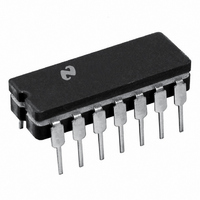LM148J National Semiconductor, LM148J Datasheet - Page 7

LM148J
Manufacturer Part Number
LM148J
Description
IC OP AMP QUAD 741 14-CDIP
Manufacturer
National Semiconductor
Type
General Purpose Amplifierr
Datasheet
1.LM348M.pdf
(15 pages)
Specifications of LM148J
Amplifier Type
General Purpose
Number Of Circuits
4
Slew Rate
0.5 V/µs
Gain Bandwidth Product
1MHz
Current - Input Bias
30nA
Voltage - Input Offset
1000µV
Current - Supply
2.4mA
Current - Output / Channel
25mA
Voltage - Supply, Single/dual (±)
10 V ~ 44 V, ±5 V ~ 22 V
Operating Temperature
-55°C ~ 125°C
Mounting Type
Through Hole
Package / Case
14-CDIP (0.300", 7.62mm)
Rail/rail I/o Type
No
Number Of Elements
4
Unity Gain Bandwidth Product
1MHz
Common Mode Rejection Ratio
70dB
Input Offset Voltage
5mV
Input Bias Current
100nA
Single Supply Voltage (typ)
Not RequiredV
Power Dissipation
1.1W
Voltage Gain In Db
104.08dB
Power Supply Requirement
Dual
Shut Down Feature
No
Single Supply Voltage (min)
Not RequiredV
Single Supply Voltage (max)
Not RequiredV
Dual Supply Voltage (max)
±22V
Technology
Bipolar
Operating Temp Range
-55C to 125C
Operating Temperature Classification
Military
Mounting
Through Hole
Pin Count
14
Package Type
CDIP
Lead Free Status / RoHS Status
Contains lead / RoHS non-compliant
Output Type
-
-3db Bandwidth
-
Lead Free Status / Rohs Status
Not Compliant
Other names
*LM148J
Available stocks
Company
Part Number
Manufacturer
Quantity
Price
Part Number:
LM148J
Manufacturer:
NS/国半
Quantity:
20 000
Part Number:
LM148J/883C
Manufacturer:
NS/国半
Quantity:
20 000
Part Number:
LM148J/883Q
Manufacturer:
NS/国半
Quantity:
20 000
Application Hints
The LM148 series are quad low power 741 op amps. In the
proliferation of quad op amps, these are the first to offer the
convenience of familiar, easy to use operating characteris-
tics of the 741 op amp. In those applications where 741 op
amps have been employed, the LM148 series op amps can
be employed directly with no change in circuit performance.
The package pin-outs are such that the inverting input of
each amplifier is adjacent to its output. In addition, the
amplifier outputs are located in the corners of the package
which simplifies PC board layout and minimizes package
related capacitive coupling between amplifiers.
The input characteristics of these amplifiers allow differential
input voltages which can exceed the supply voltages. In
addition, if either of the input voltages is within the operating
common-mode range, the phase of the output remains cor-
rect. If the negative limit of the operating common-mode
range is exceeded at both inputs, the output voltage will be
positive. For input voltages which greatly exceed the maxi-
mum supply voltages, either differentially or common-mode,
resistors should be placed in series with the inputs to limit
the current.
Like the LM741, these amplifiers can easily drive a 100 pF
capacitive load throughout the entire dynamic output voltage
and current range. However, if very large capacitive loads
must be driven by a non-inverting unity gain amplifier, a
resistor should be placed between the output (and feedback
connection) and the capacitance to reduce the phase shift
resulting from the capacitive loading.
Typical Applications—LM148
f
R1 = 100k pot. C1 = 0.0047 µF, C2 = 0.01 µF, C3 = 0.1 µF, R2 = R6 = R7 = 1M,
R3 = 5.1k, R4 = 12Ω, R5 = 240Ω, Q = NS5102, D1 = 1N914, D2 = 3.6V avalanche
diode (ex. LM103), V
A simpler version with some distortion degradation at high frequencies can be made by using A1 as a simple inverting amplifier, and by putting back to back
zeners in the feedback loop of A3.
MAX
= 5 kHz, THD ≤ 0.03%
S
=
±
15V
One Decade Low Distortion Sinewave Generator
7
The output current of each amplifier in the package is limited.
Short circuits from an output to either ground or the power
supplies will not destroy the unit. However, if multiple output
shorts occur simultaneously, the time duration should be
short to prevent the unit from being destroyed as a result of
excessive power dissipation in the IC chip.
As with most amplifiers, care should be taken lead dress,
component placement and supply decoupling in order to
ensure stability. For example, resistors from the output to an
input should be placed with the body close to the input to
minimize “pickup” and maximize the frequency of the feed-
back pole which capacitance from the input to ground cre-
ates.
A feedback pole is created when the feedback around any
amplifier is resistive. The parallel resistance and capacitance
from the input of the device (usually the inverting input) to AC
ground set the frequency of the pole. In many instances the
frequency of this pole is much greater than the expected 3
dB frequency of the closed loop gain and consequently there
is negligible effect on stability margin. However, if the feed-
back pole is less than approximately six times the expected
3 dB frequency a lead capacitor should be placed from the
output to the input of the op amp. The value of the added
capacitor should be such that the RC time constant of this
capacitor and the resistance it parallels is greater than or
equal to the original feedback pole time constant.
00778608
www.national.com











